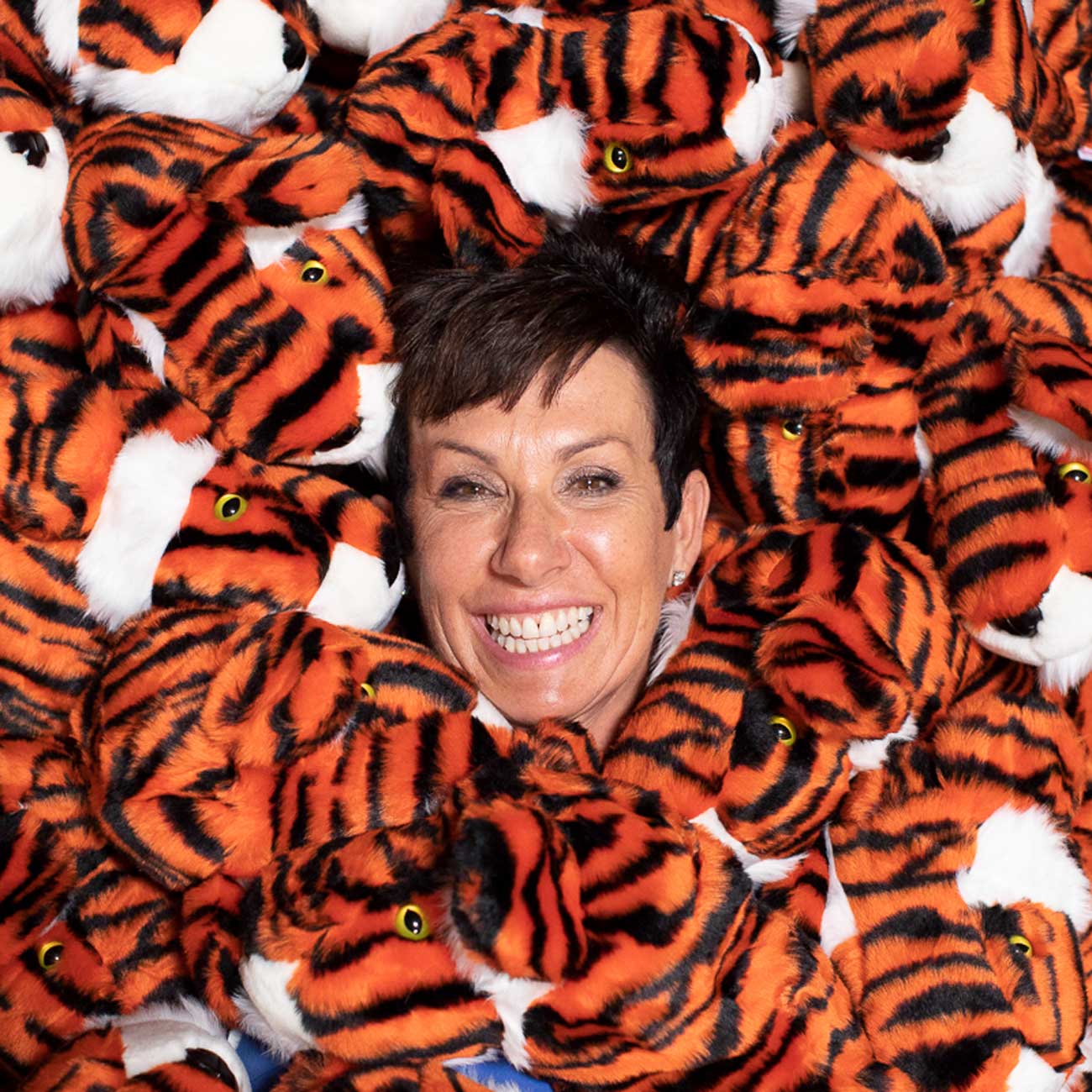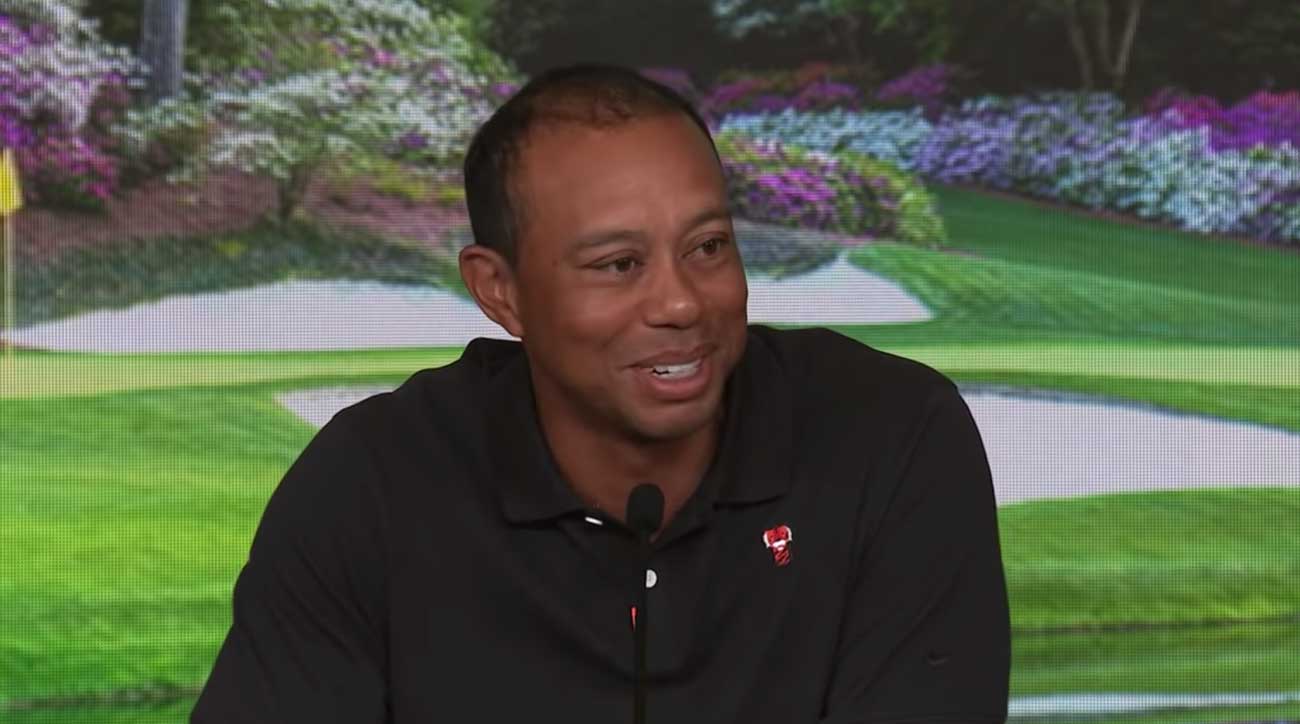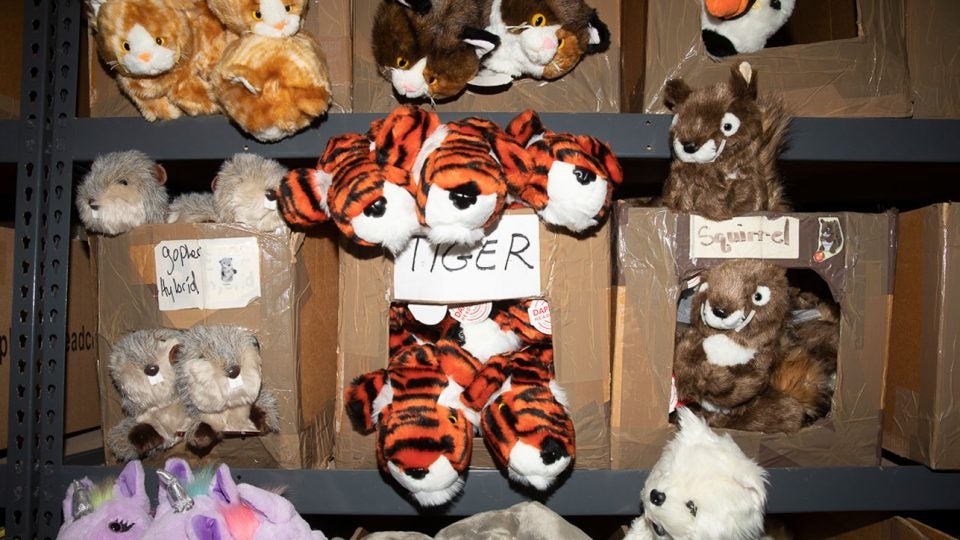Six tiger headcovers are jammed in the corner closet of Jane Spicer’s North Phoenix office. She’s hiding them there, tucked behind a cardboard bin of paperwork. The office is locked, just in case.
Spicer isn’t hiding those headcovers from you or me or some headcover burglar. She’s guarding against total catastrophe. If anything tragic happened to her nearby warehouse — which holds more than 10,000 headcovers and their decades-old designs — she would always have those six tigers in their own little cage. Consider them headcover insurance, because Spicer just never knows when Tiger Woods’ mother, Tida, will come calling again for a replacement.
Spicer, 56, is the always-smiling CEO of Daphne’s Headcovers, and through luck, persistence and a commitment to her customers (see above), she has provided the 15-time major winner with his world famous tiger headcover for 24 years. When Tida Woods phones, all other calls get dropped. It’s the most important business Spicer has.
“I remember three dates,” she says with a chuckle. “The birthdays of my two children and the date that Tiger first won the Masters. That’s pretty much it.”
It was April 13, 1997, when a spry 21-year-old Woods won by 12 strokes at Augusta National. He did it with a glowing smile, his classic red-and-black outfit and a curious tiger headcover atop his golf bag. Woods had toted the Daphne’s headcover for a few years, winning his final two U.S. amateur titles with it, but the Masters was an international moment. The golf world’s eyes were fixated on the young phenom prowling around Augusta National, that headcover following like an obedient pet. Spicer’s business quickly reaped the considerable benefits: a phone order for 30,000 headcovers.
It had to be a joke, right? Nope. American Express, one of Woods’ deep-pocketed sponsors at the time, was no joke. The company not only wanted 30,000 tigers, it offered to pay an extra $30,000 for expedited service. When a fat check arrived overnight, a baffled Spicer still couldn’t believe what was happening. She held the check up to the light, examining the paper for hints of a counterfeit. She then sprinted into the office, tripped on her way up the stairs and crashed onto the floor.
“I skinned my knees, skinned my elbows, but I didn’t let go of that check,” Spicer says. “Everyone came running out and asked what happened. I said, ‘We just got really busy, guys.’ That was the start.”
Her beginnings were even more humble than that stumble. Spicer began making and selling puppets at age 10, with her entrepreneurial mother and company’s namesake, Daphne Kronstorfer, providing business advice and plenty of inspiration. After six years of puppet-making, Spicer was an underclassman at the affluent Phoenix Central High School, desperate to fit in with a car of her own. A puppet customer suggested she make headcovers, and her mother put a price on it, telling her daughter, “If you sell enough, I’ll buy you a car.”

It quickly became lore that Tida would give her son a new tiger headcover each year, with the words Rak jak Mea (Thai for “Love from Mom”) hand-sewn on the back. At the end of each year, Tida would write down her son’s accomplishments and stuff the note into that year’s headcover, storing them away like furry scrapbooks of memories.
Nowadays, Tida contacts Spicer directly. “Every repartee has been pleasant,” Spicer says. “She’s got loads of beautiful energy. She’s a loving mom. I loved my mom. There’s just a familial understanding of those bonds. It’s always been pleasant.”
The mother-child dynamic with the tiger is twofold. The tiger was designed by Daphne Kronstorfer herself, and her daughter would never consider changing it, even after 40 years of doing business. Her mom was her role model, and when Daphne passed in late 1996, Spicer struggled to adapt to life without her. The next spring, Woods changed the fate of her company forever, reinvigorating her business. Demand was so high, her newborn son slept on the floor in her office. There was no time to go home. “We hired every seamstress in the valley,” Spicer recalls.
Sales grew 400 percent, and Spicer repeatedly fended off copyright infringers. Tens of thousands of golf fans have followed AmEx’s lead, and 22 years later, Daphne’s tiger is undoubtedly the most popular headcover in the world. Understandably, it wasn’t all Spicer.

In the early 2000s, Woods regularly accomplished the impossible. He won the ‘Tiger Slam,’ triumphing in four straight majors, as well as seven out of 11. He won six times in six starts on the PGA Tour, was named Sportsperson of the Year by Sports Illustrated (twice) and became the most popular athlete in the world.
Back at Nike Headquarters, the upstart golf division was trying to move product and compete with industry titans like Callaway, Titleist and TaylorMade. Nike execs aimed to leverage Woods, a golfing robot, as a more aspirational, viable leader for the golfing masses. Nike wanted to humanize his heroics.
As it had successfully done with Mars Blackmon alongside Michael Jordan, and Lil’ Penny with Penny Hardaway, Nike summoned the genius of creative marketing brand Weiden and Kennedy, a small Portland agency, to create a foil for Woods. Someone or something that could remove Woods’ layer of invisibility.
Creative director Jim Riswold saw Woods’ funky headcover and conceived “Frank,” a spitfire character — his body licensed from Daphne’s, of course — who knew Woods better than anyone. Here’s how his pitch read. (He still holds onto it to this day.)
Meet Frank. Frank is one of Tiger’s inner-circle. He is Tiger’s bon ami. He’s also Tiger’s confidant. In other words, when Frank speaks, Tiger listens, but not as much as Frank thinks he should. Frank is also the headcover for Tiger’s driver. Frank and Tiger have been together since childhood. Frank was at Tiger’s appearance on the Mike Douglas Show. Frank was with Tiger at his three USGA Junior championships. Frank was with Tiger at his three U.S. Amateurs. Frank was with Tiger at Stanford, graduating with a degree in accounting.
They go everywhere and do everything together. Golf tournaments, obviously, the practice range, the gym, the stores, the movies, the fishing hole, the coffee shop, the dating scene, you name it. Frank and Tiger do it together. Frank is not some airy, fairy Baggar Vance, speaking oblique and obtuse terms. Frank is, well, frank, and outspoken. You know where you stand with Frank — just ask Tiger. Frank, as we shall see, also has a lot more interests in life than golf. He’s a devout bon vivant, a proponent of the good life, who has particular fondness for singing. Oh, one other thing: Never call Frank a sock. Never.
“Oh, and also,” Riswold added. “He’s the only guy who gets to call Tiger [by his real name,] “Eldrick.”
Initially, the pitch was met with reserve. What Riswold proposed was a brand campaign — a series of ads that would promote Nike as a bold, lively golf entity. “Nike being Nike,” as marketing director Chris Mike put it. But that’s not what Nike Golf needed. As it ranked below its competitors in the equipment space, Nike Golf wanted a product campaign that would prioritize sales and add to its bottom line. While there was some compromise needed by both sides, there was plenty of trust in the relationship. Weiden and Kennedy (with Riswold as the lead) had delivered in a big way with the “Hello World” and “I am Tiger Woods” campaigns in earlier years.
“Riswold is a genius,” Woods’ longtime agent Mark Steinberg said. “When he comes up with an idea, you really gotta stand up and pay attention.”
Riswold wrote dozens of scripts for Frank, and with a robust budget for talent, the brand hired legendary commercials director Joe Pytka (known for Budweiser’s Clydesdale spots and the Michael Jordan/Larry Bird McDonald’s commercial, to name a few). Pytka is a tall, imposing perfectionist, and infamous for his intense directing style. It was not abnormal for arguments to break out on set, often leading to spur-of-the-moment rewrites for Riswold’s team.
As for the witty, biting voice of Frank, three men were tabbed as finalists: comedic producer and actor Larry David, Hollywood mainstay Michael Keaton, and up-and-comer Paul Giamatti. According to Riswold, David was the popular choice, but in exchange for the work, all he wanted was to play a round with Woods. He was denied and Giamatti got the job.
The physical Frank doll was an animatronic puppet, brought to life by five puppeteers who stood directly behind the camera, each flexing bike cables to move specific portions of Frank’s body. One cable for each ear. One cable for the lower part of its mouth. One for the upper lip, which frayed whenever Frank spoke. Overseeing it all was puppet-mastermind Jaime Hyneman, who eventually went on to host the popular Discovery TV show, Mythbusters. (Hyneman still holds onto the robot as a keepsake.)
“Do we really want him to spend 30 or 40 thousand dollars on a robot for this? Is it really that important,” Mike asked himself at the time. “I’m glad we did. It was an amazing piece of technology at the time. Could have bought a car with it.”
The commercials revolved around Frank’s demanding, know-it-all attitude and Woods’ indifference to him. Frank knew where Woods could improve, and he wasn’t afraid to say it.
There’s Frank, in the barbershop getting his fur trimmed next to Woods, ranting about the tungsten plug in Nike’s new fairway woods. Then there’s Frank at the bar, counseling Tiger about how he’s been “dinkin’ it” around the course lately, encouraging him to use Nike’s Tour Accuracy 2 ball. “We made fun of Tiger,” Riswold said. “Nobody was making fun of Tiger then.”
ADVERTISEMENT
The nine-spot commercial series ran throughout 2003 and 2004, with Frank becoming a golf culture icon. Soon enough he was being interviewed by USA Today. But after 2004? Nothing. Frank went missing almost entirely. Nowhere but on Woods’ bag itself. According to Riswold, Woods’ mother loved the campaign, and wanted them to bring it back, but he was never asked to produce more scripts.
“That’s typical Nike and it’s typical Weiden and Kennedy,” Steinberg says. “They capitalize, they’re smart, they’re creative. Then they shut it down and if there’s a moment in time to bring it back as a sequel, they bring it back. Nike, sure as hell, did it this time.”

As Woods struggled with back issues and off-the-course mishaps in the late 2000s, those commercials became even more distant relics. In August, 2016, Nike abruptly exited the equipment industry, intending to focus strictly on golf shoes and clothing. Without any equipment to hawk, and without his main man winning tournaments, Frank was no more.
But then came Woods in a triumphant return in 2018, winning the Tour Championship and flirting with his 15th major. In advance of the 2019 Masters, Nike prepped Frank-centered apparel, releasing polos with tiny, cartoon Frank logos on the chest. Practicing in other gear during the day, Woods trotted the polo out for the first time during his pre-tournament press conference. Nike teased it appropriately on Instagram.
The gear was released exclusively to Nike members and sold out almost immediately, resurfacing on EBay for as much as $300. Five days later, Woods won the tournament, and when he walked off the 18th green he embraced his son, daughter, and longtime friend Rob McNamara. They were all wearing Frank-logoed hats. Once again, the ripple effects of a Tiger Woods victory were extensive. Daphne’s Headcovers was sent into a frenzy.
Five weeks later Woods was bundled up in a stocking cap and sweater, playing a practice round at an abnormally chilly Bethpage Black. When it was time to talk to the press, again, he yanked off all his cold weather gear to reveal a bright white polo with that little mouthy headcover on his chest. As an icon, Frank lives on.
Over at Daphne’s Arizona headquarters, relics of his Masters win still hang on the walls. A Frank t-shirt is draped over the door to Spicer’s office. The hallways are lined with picture frames, plaques and reminders of everywhere the tiger headcover has traveled. It’s only once you walk past those mementos that you realize the true depth of Daphne’s headcover ecosystem. They make cougars, cats, quail, chimps and 25(!) different species of canines — the warehouse might as well be Noah’s Ark. Joining the tiger on Tour is Ernie Els’ lion and Padraig Harrington’s ladybug. And don’t forget about Craig Stadler’s walrus. Aaron Baddeley loves Daphne’s koala bear so much he even got involved in the design process. More than 200 elite professionals have carried Daphne’s headcovers throughout their careers.
Despite her incredible success, Spicer urges innovation with annual trips to east Asia, where she meets with designers at their main factory. Ninety-five percent of their headcovers are made there before getting shipped to more than 75 countries.
The remaining headcovers are produced in Phoenix, where on this given Wednesday, a group of women work diligently sewing their own species by hand. Someone, somewhere wants a turtle to cover their TaylorMade or a calico cat on their Callaway. Don’t even bother asking Spicer which headcover is her favorite. She won’t bite. “That’s like making me choose between my kids,” she says.
Every design is obviously important to Daphne’s bottom line, but it’s all a cute dressing of the truth. Another 100-square-foot slab of orange and black fur has been rolled out onto the industrial CNC machine nearby. It will be cut into hundreds of tiny tiger ears. There’s no question who is king of the headcover jungle.
To receive GOLF’s newsletters, subscribe for free here.
ADVERTISEMENT



